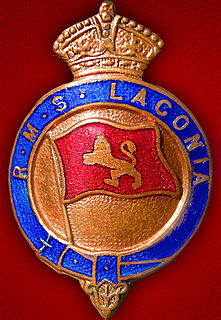
Royal Mail Ship, usually seen in its abbreviated form RMS, is the ship prefix used for seagoing vessels that carry mail under contract to the British Royal Mail. The designation dates back to 1840. Any vessel designated as "RMS" has the right both to fly the pennant of the Royal Mail when sailing and to include the Royal Mail "crown" insignia with any identifying device and/or design for the ship.
Several ships have been named Innisfallen, the name being derived from the island of Innisfallen in County Kerry and often given to vessels serving the southerly coasts of Ireland. Five served on the Irish Sea route between Cork and Fishguard, from 1896 onwards: two of these were war casualties whilst the remainder have been either scrapped or renamed and sold to new owners.

RMS Leinster was an Irish ship operated by the City of Dublin Steam Packet Company. She served as the Kingstown-Holyhead mailboat until she was torpedoed and sunk by the German submarine UB-123, which was under the command of Oberleutnant zur See Robert Ramm, on 10 October 1918, while bound for Holyhead. She sank just outside Dublin Bay at a point 4 nautical miles (7.4 km) east of the Kish light.

The National Maritime Museum of Ireland opened in 1978 in the former Mariners' Church in Moran Park, located between the seafront and the centre of Dún Laoghaire town, southeast of Dublin city. President Michael D. Higgins officially re-opened the museum in 2012.

The City of Dublin Steam Packet Company was a shipping line established in 1823. It served cross-channel routes between Britain and Ireland for over a century. For 70 of those years it transported the mail. It was 'wound-up' by a select committee of the House of Lords in 1922 and finally liquidated in 1930.

The Kish Bank is a shallow sand bank about seven miles (11 km) off the coast of Dublin, in Ireland. It is marked by the Kish Lighthouse, a landmark well known to sailors and ferry passengers passing through Dublin Bay and Dún Laoghaire harbour.

Public Armed Ship Muirchú was a ship in the service of Irish Free State's Coastal and Marine Service (CMS). She was the former Royal Navy ship HMY Helga and was involved in shelling Liberty Hall in Dublin from the River Liffey with her pair of 12-pounder naval guns during the Easter Rising of 1916.
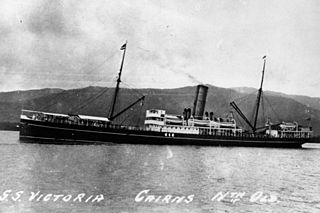
The Pacific Steam Navigation Company was a British commercial shipping company that operated along the Pacific coast of South America, and was the first to use steam ships for commercial traffic in the Pacific Ocean.

The British and Irish Steam Packet Company Limited was a steam packet and passenger ferry company operating between ports in Ireland and in Great Britain between 1836 and 1992. It was latterly popularly called the B&I, and branded as B&I Line.
HMS Snowdrop was an Azalea-class sloop of the Royal Navy. She served during the First World War. Snowdrop survived the war and was sold for scrap in 1923.

The action of 5 September 1918 was a naval battle 200 mi off the coast of France in the North Atlantic during World War I. The action was fought between a German U-boat and American warships.

RMS Ebro was an ocean liner built in 1914 for the Royal Mail Steam Packet Company. She was later owned and operated by the Pacific Steam Navigation Company, Jugoslavenska Lloyd and finally by Companhia Colonial de Navegação. In her last incarnation, under the name Serpa Pinto, she made more crossings of the Atlantic during the Second World War than any other civilian vessel, leading to her being termed the Friendship vessel or Destiny ship. She was scrapped in 1954.
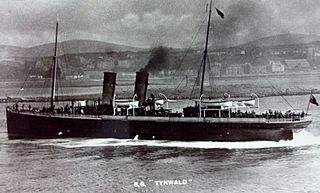
SS (RMS) Tynwald (III), No. 95755, was an iron passenger steamer which served with the Isle of Man Steam Packet Company, and was the third vessel in the Company to bear the name.
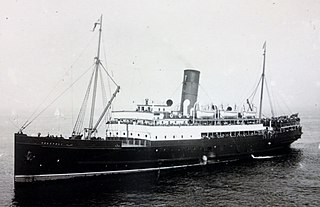
RMS Snaefell (III) – the third ship in the line's history to be so named – was a packet steamer operated by the Isle of Man Steam Packet Company from 1910 to 1914. She was then acquired by the Admiralty at the outbreak of the First World War, until she was torpedoed and sunk in the Mediterranean on 5 June 1918.

SS (RMS) Empress Queen was a steel paddle steamer, the last of its type ordered by the Isle of Man Steam Packet Company. She was chartered by the Admiralty in 1915 and used for trooping duties until she ran aground off Bembridge, Isle of Wight, England in 1916 and was abandoned.
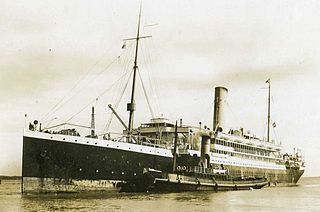
HMT Aragon, originally RMS Aragon, was a 9,588 GRT transatlantic Royal Mail Ship that served as a troop ship in the First World War. She was built in Belfast, Ireland in 1905 and was the first of the Royal Mail Steam Packet Company's fleet of "A-liners" that worked regular routes between Southampton and South American ports including Buenos Aires.

SM UB-123 was a German Type UB III submarine or U-boat in the German Imperial Navy during World War I. She was commissioned into the German Imperial Navy on 6 April 1918 as SM UB-123.
HMS Paxton was a First World War Royal Navy Q-ship torpedoed and sunk by the German submarine U-46 on 20 May 1917 in the Atlantic Ocean 90 miles (140 km) west of Great Skellig, Eire. The ship was originally ordered as Lady Patricia for the British and Irish Steam Packet Company but taken over on completion by the British Government as HMAV Lady Patricia.

RMS Amazon was a transatlantic Royal Mail Ship that the Royal Mail Steam Packet Company operated on scheduled services between Southampton and South American ports including Buenos Aires. She was the second of the RMSP's fleet of "A" series liners, and was launched in 1906.
















